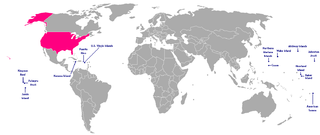
An insular area of the United States is a U.S. territory that is neither a part of one of the 50 states nor of a Federal district. Article IV, Section 3, Clause 2 of the United States Constitution grants to United States Congress the responsibility of overseeing these territories, of which there are currently 14—three in the Caribbean Sea and 11 in the Pacific Ocean. These territories are classified by whether they are incorporated and whether they have an organized territorial government established by the U.S. Congress through an Organic Act. All territories but one are unincorporated, and all but four are considered to be unorganized. Five U.S. territories have a permanent, nonmilitary population. Each of them has a civilian government, a constitution, and enjoys some degree of local political autonomy.

Territories of the United States are sub-national administrative divisions overseen by the federal government. They differ from U.S. states and Native American tribes, which have limited sovereignty. The territories are classified by incorporation and whether they have an "organized" government through an organic act passed by Congress.

The Office of Insular Affairs (OIA) is a unit of the United States Department of the Interior that oversees federal administration of several United States insular areas. It is the successor to the Bureau of Insular Affairs of the War Department, which administered certain territories from 1902 to 1939, and the Office of Territorial Affairs in the Interior Department, which was responsible for certain territories from the 1930s to the 1990s. The word "insular" comes from the Latin word insula ("island").
In the United States, each state has its own constitution.
These are lists of school districts in the United States.
Pacific Islands Americans, also known as Oceanian Americans, Pacific Islander Americans or Native Hawaiian and/or other Pacific Islander Americans, are Americans who have ethnic ancestry among the indigenous peoples of Oceania. For its purposes, the U.S. Census also counts Indigenous Australians as part of this group.
Under United States law, an unincorporated territory is an area controlled by the United States government that is not part of the United States. In unincorporated territories, the U.S. Constitution applies only partially. In the absence of an organic law, a territory is classified as unorganized. In unincorporated territories, "fundamental rights apply as a matter of law, but other constitutional rights are not available". Selected constitutional provisions apply, depending on congressional acts and judicial rulings according to U.S. constitutional practice, local tradition, and law.

The District of Columbia and United States Territories Quarter Program was a one-year coin program of the United States Mint that saw quarters being minted in 2009 to honor the District of Columbia and the unincorporated United States insular areas of Puerto Rico, Guam, United States Virgin Islands, American Samoa, and the Northern Mariana Islands. The islands commonly grouped together as the United States Minor Outlying Islands were not featured, as the law defined the word "territory" as being limited to the areas mentioned above. It followed the completion of the 50 State Quarters program. The coins used the same George Washington obverse as with the quarters of the previous ten years. The reverse of the quarters featured a design selected by the Mint depicting of the federal district and each territory. Unlike on the 50 State quarters, the motto "E Pluribus Unum" preceded and was the same size as the mint date on the reverse.
The Northern Mariana Islands National Guard is a proposed National Guard unit to be formed in the Commonwealth of the Northern Mariana Islands. Currently, residents of the Northern Mariana Islands may serve in the Guam National Guard.








